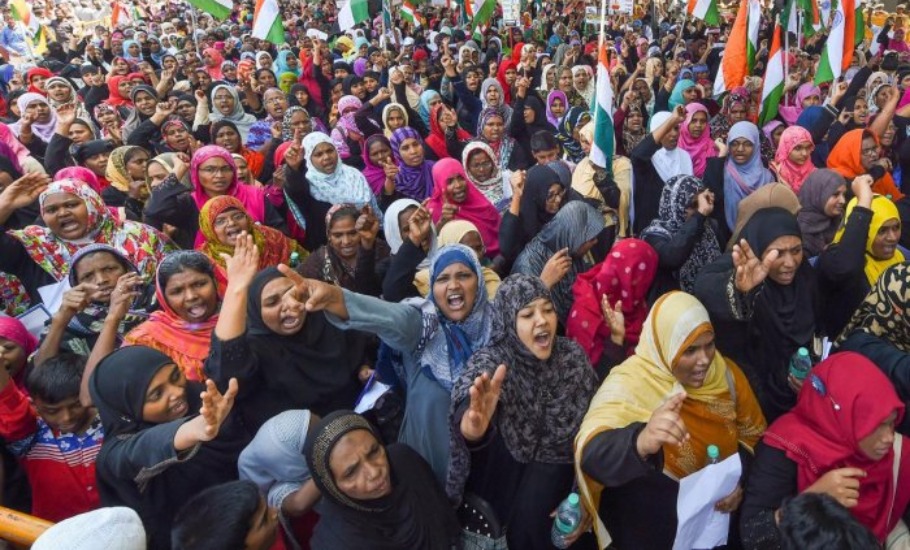
Communal tension prevails in parts of TN over pro and anti-CAA protests
Anti-citizenship law protests inspired from the Shaheen Bagh model that broke out across Tamil Nadu has taken a new shape, leading to a simmering communal tension in parts of the state. Despite rejection from the Muslims, the Left and Dalit parties in the state continue to support the Muslims protesting against the CAA, NRC, and NPR.

Anti-citizenship law protests inspired from the Shaheen Bagh model that broke out across Tamil Nadu has taken a new shape, leading to a simmering communal tension in parts of the state.
Despite rejection from the Muslims, the Left and Dalit parties in the state continue to support the Muslims protesting against the Citizenship Amendment Act (CAA), the National Register of Citizens (NRC), and the National Population Register (NPR), and slamming the police for their alleged biased action against minorities.
This may be traced back to when Hindu outfits started demonstrating against the anti-CAA protests in the state, and it took an ugly turn on March 5 when Anand, a Hindu Munnani functionary, was assaulted by unidentified persons on his way back from a pro-CAA demonstration in Coimbatore.
Even before the police could arrest the assailants, unidentified persons hurled a petrol bomb at a mosque in the city, in an apparent counter attack. Consequently, these attacks and counter-attacks led to the brewing of communal tension in the city.
This is not limited just to Coimbatore district which witnessed a Shaheen Bagh-like demonstration in its Aathupalam area. The attack, counter-attacks, and the accusations against police for their alleged inaction when it comes to CAA protests have been rampant in districts like Tirupur, Tirunelveli, and Trichy.
Related news: Petrol bomb hurled at Hindu Munnani office in Coimbatore
A Muslim organisation in Coimbatore had suspended their protests for five days after District Collector K Rajamani requested them to suspend all their rallies and public meetings in order to maintain communal harmony.
But, defying the assurance given to the district collector during the peace committee meeting, the Rashtriya Swayamsevak Sangh (RSS) took out a rally with over 2,000 members from the Anna Statue to the District Collectorate on Thursday (March 12) evening.
Police said they didn’t authorise any such rally, but it didn’t register any case in this regard until Friday evening.
Speaking about the issue, Coimbatore city police commissioner Sumit Sharan said all the Hindu and Muslim outfit workers involved in the attacks and counter attacks will be brought to book. “We are maintaining a tight vigil in the city with adequate police presence in and around it to instil confidence among the people. All violators will be booked and action will be initiated,” he said
Though the Shaheen Bagh model protests had erupted in Tamil Nadu only after the police lathi-charged protesters in north Chennai’s Washermanpet, protests still going on there have been peaceful and support has been pouring from different quarters, including the DMK.
Related news: Worry mounts in Coimbatore after 2 mosques come under attack
Moreover, apart from the DMK, not many activists from other political parties were spotted in such protests in other cities.
“It is not that other political parties are not ready to support the minorities in the cities other than Chennai. It is the model adopted by the protesters in those cities,” said a CPI(M) worker in Coimbatore.
“In Coimbatore, we went in person to extend our support to the Muslim protesters. But the organisers asked us to leave and did not allow us to even interact with people over there. In that case, we really don’t know how much they could understand the issue constitutionally, than communally,” he added.
A cross section of politicians belonging to the DMK, CPI, CPI(M), and Viduthalai Chiruthaigal Katchi (VCK) echoed the same.
“Just because they (Muslims) avoided us, we cannot let the minorities suffer at the hands of police. It started after the police allowed the Hindu outfits to erect temporary structures wherever they wanted, and sit and protest in favour of the CAA, while the Muslims were protesting in only one place in every city,” said a district functionary of the DMK in Tirupur.
“It was an intelligence failure of the state police that led to the communal tension in Coimbatore and Tirupur,” he said.
Related news: Fear, insecurity, unity behind Chennai’s own Shaheen Bagh protest
What fuels such allegations of intelligence failure is the move to replace Vetriselvan, ACP, Special Intelligence Cell, Coimbatore with C Chandrasekar. The move came in view of the escalating communal tension in the district and even before a review meeting was conducted on the security scheme.
A retired Assistant commissioner of police in Special Intelligence Cell, who did not want to be named, opined it is easy to converse with a politically aware crowd than a communally polarised one.
“You can easily distinguish between the crowds in Chennai with the other cities. The protesting Muslims in Washermanpet often recite the Preamble of the Constitution. But people protesting in other parts of the state don’t even know how the CAA, NRC or NPR are discriminatory. So, a communally polarised crowd would only lead to communal tension and if it is not sensed early, it would end up in a communal riot,” said the retired officer.
Meanwhile, DGP JK Tripathy took stock of the situation in the cities and held a review meeting about the security scheme at the police headquarters on Thursday.
He has also deputed four additional directors general of police — Jayant Murali, Shankar Jiwal, Sailesh Kumar Yadav and Mahesh Kumar Agarwal in Coimbatore, Tirupur, Trichy and Tirunelveli respectively — to monitor the security scheme and maintain law and order in the cities.
Till now, 200 people have been arrested in these four districts, including 127 people in Coimbatore city alone.
Related news: Muslim clerics meet Rajinikanth, apprise him of CAA-NRC-NPR effect

